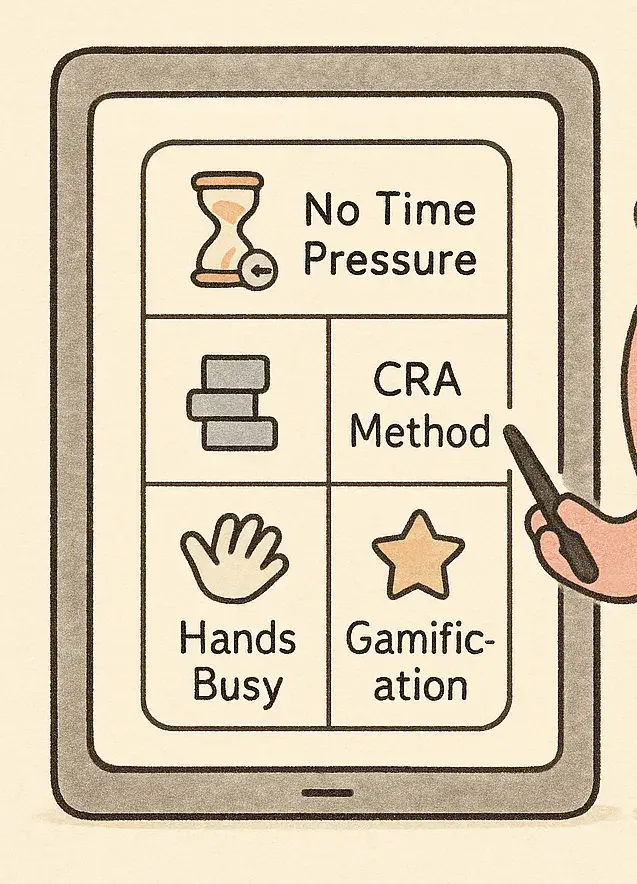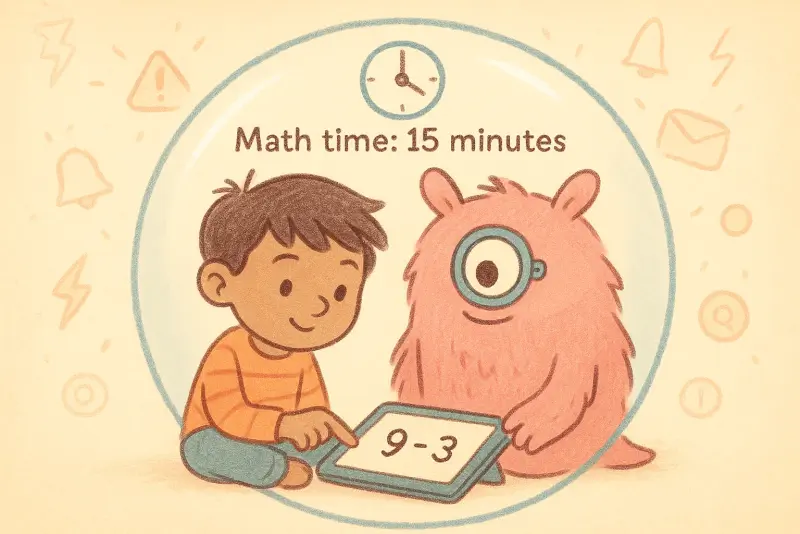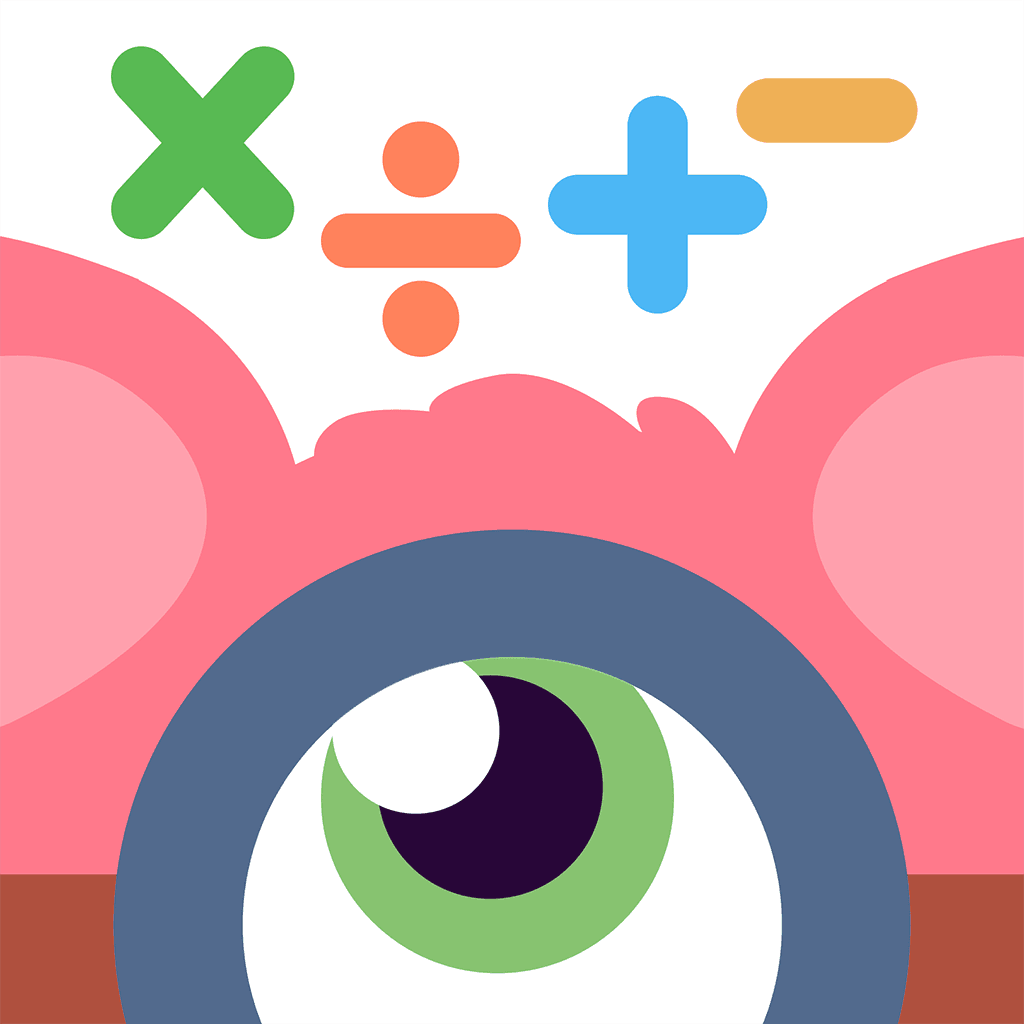ADHD-Friendly App Design: What to Look For (and What to Avoid)
TL;DR:
- Look For: No timers or rushing mechanics; CRA (Concrete-Representational-Abstract) progression for math concepts; interactive touch elements to keep hands busy; gamified rewards without pressure.
- Avoid: Cluttered interfaces, strict deadlines, overwhelming visuals, or passive content that doesn't engage movement.
- Pro Tip: Apps like Monster Math incorporate all these for fun, effective math practice—check it out for your little learner!
- Why It Matters: Research shows these features improve attention and self-regulation in kids with ADHD.
As a parent or teacher of a child with ADHD, finding the right educational app can feel like a game-changer. But not all apps are created equal - especially when it comes to supporting neurodiverse learners who thrive with thoughtful design. In this guide, we'll break down key ADHD-friendly app design principles, backed by peer-reviewed research, to help you spot apps that boost focus, reduce frustration, and spark joy in learning. We'll also cover pitfalls to dodge.
Whether you're hunting for math tools or daily skill-builders, prioritizing apps that align with evidence-based strategies can make homework time smoother and school days brighter. Let's dive in.
Understanding ADHD and App Design: A Parent and Teacher's Perspective
Kids with ADHD often face challenges like sustaining attention, managing time, and regulating impulses, which can turn even fun apps into sources of stress. But well-designed apps can flip the script by leveraging principles from universal design for learning (UDL) and sensory supports. For parents juggling after-school routines and teachers navigating diverse classrooms, these tools aren't just nice-to-haves - they're essential for building confidence and skills.
Our focus here draws from rigorous studies on educational tech for neurodiverse children, emphasizing strategies like reducing cognitive overload and anxiety, and encouraging active engagement.
What to Look For: Key Features in ADHD-Friendly Educational Apps
Great apps for children with ADHD prioritize flexibility, interaction, and motivation. Here's what research recommends, tailored for everyday use in math, reading, or skill-building.

No Time Pressure: Building Confidence Without the Rush
Time blindness is a common hurdle for kids with ADHD, making strict timers feel punishing rather than helpful. A lot of apps use timed-worksheet style interactions, using the timer to add a layer of motivation. This doesn't work for kids who have ADHD.
Instead, opt for apps that allow self-paced exploration, using gentle reminders or progress trackers without countdowns. Timers could be used to time the session (15-mins of Math, for e.g.), rather than timing the child's performance ("finish these problems before the time runs out").
For parents, this means less "Hurry up!" battles; for teachers, it fosters inclusive group activities. Look for features like adjustable session lengths or "pause anytime" options to match your child's energy.
CRA Method: Hands-On Math Learning That Sticks
The Concrete-Representational-Abstract (CRA) sequence is a powerhouse for teaching math to kids with ADHD and learning differences. It starts with tangible objects (concrete), moves to drawings or visuals (representational), and ends with symbols like numbers (abstract), easing the cognitive leap.
Studies show CRA boosts geometric shape recognition and perimeter skills in students with ADHD. In one experimental study, CRA instruction led to significant gains in understanding basic shapes for ADHD learners. Seek apps that layer these stages progressively—think dragging virtual blocks before solving equations—to make abstract concepts feel concrete and achievable.
Bonus: This ties into our guide on math strategies for neurodiverse kids, where CRA shines for building foundational skills without overwhelm.
Keeping Hands Busy: Fidget-Friendly Interactions
Fidgeting isn't distraction—it's a self-regulation tool that heightens arousal and sustains attention during tough tasks. For ADHD kids, apps with touch-based mechanics (swiping, tapping, or virtual manipulatives) channel that energy productively.
A classroom study using fidget spinners doubled on-task behavior in second-graders with ADHD, from 25–34% to 55–79%. Translate this to apps: Prioritize drag-and-drop puzzles or multi-touch games that keep fingers moving, mimicking fidgets while advancing learning. It's a win for wiggly hands in quiet reading corners or bustling home study sessions.
Gamification: Fun Rewards That Fuel Focus
Gamification—think badges, levels, and quests—turns drills into adventures, but only if it's low-stakes. Meta-analyses of gamified digital interventions report modest improvements in ADHD symptoms (Hedges' g = 0.28), especially with computer-based formats that allow deeper immersion without mobile distractions.
Effective elements include progress bars for small wins and narrative-driven challenges that build executive function. A systematic review of serious games highlights stop-signal tasks (quick "go/no-go" decisions) as promising for attention training. Choose apps where "level up" feels like a high-five, not a race.
Feature | Why It Helps ADHD Kids | Example in Action |
|---|---|---|
No Time Pressure | Reduces anxiety, improves time orientation | Self-paced modules with optional hints |
CRA Method | Bridges concrete to abstract thinking | Virtual blocks → drawings → equations |
Hands Busy (Fidgets) | Boosts sustained attention via movement | Interactive swipes and taps during lessons |
Gamification | Enhances motivation without overload | Badge-earning quests for daily practice |

What to Avoid: Red Flags in App Design for Neurodiverse Kids
Not every shiny app suits ADHD brains. Steer clear of:
- Overloaded Screens: Cluttered interfaces spike distractibility - UDL principles stress clean, multi-modal representations instead.
- Strict Deadlines: Countdowns amplify impulsivity; opt for flexible pacing per the time intervention research.
- Passive Viewing: Videos without interaction miss fidget benefits - ensure active elements to maintain engagement, ideally keeping the child interacting with the screen.
- High-Stakes Rewards: Punitive "fail" mechanics demotivate; gamification should celebrate effort, not perfection.
By dodging these, you create space for your child's strengths to shine.
How Monster Math Masters ADHD-Friendly Design
Enter Monster Math, our app for turning math woes into monster-taming triumphs. It embodies these principles seamlessly:
- No Time Pressure: Bite-sized levels let kids progress at their rhythm, echoing effective gamified structures.
- CRA in Action: Starts with visual representations of the math facts - then ties them to abstract numbers. This approach is proven to aid ADHD math mastery.
- Hands-On Fun: Constant swiping and tapping keeps fidgety fingers engaged, boosting on-task focus like fidget tools.
- Gamified Adventure: Collect stars and unlock worlds with low-pressure quests, to provide motivation.
Parents rave about calmer evenings, and teachers love the UDL-aligned flexibility. Download it today and watch your child's confidence roar!
Whether you choose Monster Math or any other learning app for your ADHD child - try and keep the above criteria in mind and you should have a much more positive experience!
Frequently Asked Questions (FAQs)
What makes an app truly ADHD-friendly for kids?
It reduces sensory overload, encourages movement, and uses flexible pacing - backed by UDL research for neurodiverse engagement.
How does gamification help children with ADHD without adding pressure?
By focusing on intrinsic rewards like progress badges, it enhances attention (Hedges' g = 0.28) while avoiding competition, as shown in pediatric meta-analyses.
Can fidget features in apps really improve focus for ADHD students?
Yes - interactive elements mimic beneficial fidgeting, increasing on-task behavior by up to 50%, per classroom studies.
Is the CRA method only for math apps?
Primarily, but its layered approach suits any sequential skill-building for ADHD learners, enhancing retention as in shape geometry research.
Where can I find more resources for neurodiverse teaching tools?
Explore our blog for tips, or consult peer-reviewed hubs like PubMed for the latest on classroom tech for ADHD.
Key Citations
- Universal Design for Learning for Children with ADHD (PMC, 2023)
- Usability and feasibility of a cognitive-behavioral mobile app for ADHD (PMC, 2022)
- Effectiveness of time-related interventions in children with ADHD (PMC, 2018)
- The Effect of Using CRA Sequence in Teaching Geometric Shapes to ADHD Students (ResearchGate, 2024)
- A quantitative analysis of fidgeting in ADHD (PMC, 2024)
- Using Fidget Spinners to Improve On-Task Behavior for Students With ADHD (PMC, 2022)
- Efficacy of Gamified Digital Mental Health Interventions for Pediatric Conditions (JAMA Pediatrics, 2024)
- A systematic review of serious video games for children with ADHD (PMC, 2025)
